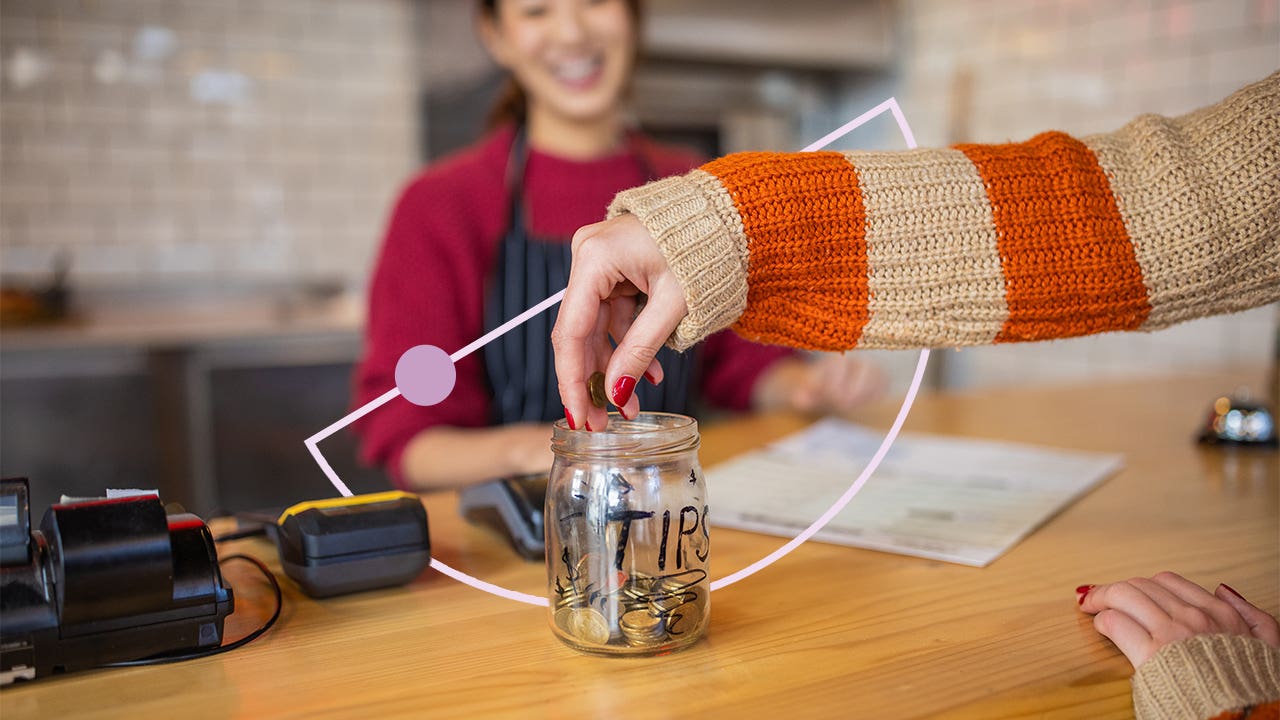Survey: More than 1 in 3 Americans think tipping culture has gotten out of control

Nora, a barista in Colorado Springs, Colorado, began earning more money when the coffee shop where she works switched from a no-tip to a tip model. But it came with some emotional baggage.
“You almost get emotionally attached to the tips,” she says. “You’re so dependent on it, it creates a level of anxiety.”
Even if the transaction was friendly, Nora says it’s off-putting when the customer doesn’t tip. In conversation with Nora, who requested not to share her last name in order to speak freely where she works, it was clear that tipping is about more than just dollars and cents.
Baristas aren’t the only people with mixed feelings about tipping. According to a new Bankrate survey on tipping culture, 59 percent of Americans view tipping negatively, down from 66 percent in 2023. This includes people who feel businesses should pay employees better, are annoyed about pre-entered tip screens or would be willing to pay higher prices to be done with tipping.
In addition, 35 percent of Americans believe tipping culture has gotten out of control. Below, we’ll explore what two people — a barista and a former server — had to say.
Tipping is a hot-button issue that doesn’t seem to be going away anytime soon.
— Ted Rossman Bankrate Senior Industry Analyst
Bankrate’s key insights on tipping in 2024
- Restaurant servers are most likely to receive tips. In addition to being most likely to receive tips (with 67 percent of restaurant-goers saying they always leave tips at sit-down restaurants) compared to workers in other industries, tipping is also up for servers since 2023 (65 percent).
- Tipping for hair stylists/barbers, food delivery people and taxi/rideshare drivers is also up from last year. Meanwhile, tipping for hotel housekeepers, coffee shop baristas, furniture/appliance delivery workers and takeout food workers is down from 2023.
- Home repair workers are least likely to receive a tip. Ten percent of customers always tip home services/repair people, the same as last year.
- Negative opinions about tipping rise with age. Forty-five percent of Gen Zers, 51 percent of millennials, 62 percent of Gen Xers and 72 percent of boomers have at least one negative view toward tipping.
- Women are generally more likely to always tip than men. Among those who use each type of service, women are more likely to always tip than men for most workers except coffee shop baristas (with 19 percent of men and 20 percent of women always tipping), furniture/appliance delivery workers (16 percent of men versus 15 percent of women) and home services/repair people (10 percent of men versus 9 percent of women).
Nearly 3 in 5 U.S. adults have a negative feeling about tipping
With Americans staring down credit card debt and picking up habits like doom spending and soft saving, it may not come as a surprise that they’re reluctant to add extra dollars to the tab. In fact, 59 percent of Americans view at least one aspect of tipping negatively, agreeing with statements like the following.
- 37 percent believe businesses should pay their employees better, rather than relying so much on tips.
- 35 percent believe that tipping culture has gotten out of control.
- 34 percent are annoyed about the pre-entered tip screens they encounter at coffee shops, food trucks and elsewhere.
- 14 percent would be willing to pay higher prices in order to do away with tipping.
- 11 percent are confused about who and how much to tip.
As people get older, their opinions about tipping seem to become more negative. Seventy-two percent of boomers (ages 60-78) and 62 percent of Gen Xers (ages 44-59) have at least one negative view toward tipping, compared to 51 percent of millennials (ages 28-43) and 45 percent of Gen Zers (ages 18-27).
But feelings about tipping aren’t all negative:
- 14 percent agree they tend to tip more when presented with a pre-entered tip screen (e.g., at coffee shops, food trucks, in mobile apps, etc.).
- 29 percent feel good when they leave a generous tip.
- 37 percent say they typically tip at least 20 percent at sit-down restaurants.
More people than last year believe tipping culture has gotten out of control
When compared to last year’s tipping survey, one opinion stands out: tipping culture has gotten increasingly out of control. More than 1 in 3 (35 percent) Americans surveyed in 2024 agreed, compared to 30 percent in 2023.
Notably, only 23 percent of Gen Zers and 27 percent of millennials think tipping culture has gotten out of control, as opposed to 40 percent of Gen Xers and 46 percent of boomers. Could younger folks be more used to modern tipping culture, while older generations remember it differently?
Jilian Locricchio, a millennial, tipping customer and former server, notes that the minimum tip suggestion for counter service seems to be 20 percent, and can run as high as 30 percent. She shares that when she worked at a counter — as opposed to serving tables — she only expected tips of 10 percent.
More people tip based on the quality of service
A majority of people (64 percent) say the amount they tip is most influenced by the quality of service. But 10 percent say they always tip the same amount regardless of the quality of service. Boomers (76 percent) and Gen Xers (67 percent) are much more likely than millennials (55 percent) and Gen Zers (50 percent) to say their tip depends on the quality of the service.
Locricchio says she’s never not tipped due to bad service. If the service is poor, she might lower her tip to 15 percent.
If you’re a server, you can have a bad day. You can be going through something terrible, and I wouldn’t know that. And the difference between that tip and no tip is a lot.
— Jilian Locricchio
People are more likely to tip less with a pre-entered tip screen
Pre-entered tip screens are pushing people’s buttons.
Thirty-four percent of Americans are annoyed about the pre-entered tip screens you might see at coffee shops, food trucks and in mobile apps. Further, 25 percent tend to tip less or not at all when presented with a pre-entered tip screen. But 14 percent tend to tip more.
More people are tipping for restaurant service, hair care, food delivery and ridesharing than in 2023
A Bankrate survey on going into debt for fun showed that Americans are spending more on travel, dining out and live entertainment this year. And new survey data indicates they’re also tipping for it.
Among U.S. adults who use each of the following services, here’s a breakdown of how many people always tip:
- Servers at a sit-down restaurant: 67 percent (up from 65 percent last year)
- Hair stylists/barbers: 55 percent (up from 53 percent last year)
- Food delivery people: 51 percent (up from 50 percent last year)
- Taxi/rideshare drivers: 41 percent (up from 40 percent last year)
It feels like a record number of businesses are soliciting tips. Tipping has become a hidden tax. Many companies are hesitant to raise prices further, given all of the increases we've seen in recent years, but asking for tips can essentially be a way for them to raise prices without acting like they're raising prices.— Ted Rossman, Bankrate Senior Industry Analyst
Older generations and women are more likely to always tip restaurant servers
Only 35 percent of Gen Zers who go to sit-down restaurants always tip, compared with 56 percent of millennials, 78 percent of Gen Xers and 86 percent of baby boomers.
Additionally, 71 percent of women and 63 percent of men who go to sit-down restaurants always tip.
“When I’m in a restaurant and I’m getting table service, I’m always tipping 20 percent and above. It was my lifeline for so many years,” says Locricchio. “I think it’s so important because the restaurant industry is kind of broken, the way they pay people.”
Fewer people are always tipping for hotel housekeeping, coffee service, furniture delivery and takeout than in 2023
On the other hand, not all services are benefiting from Americans’ tips this year.
As a barista, Nora explains that, during the summer, she gets more customers and tips. But the winters are scarce. She has to budget around that.
“Tips are such a big part of our income here,” she says.
Among U.S. adults who use each of the following services, here’s a breakdown of how many people always tip:
- Hotel housekeepers: 22 percent (down from 23 percent last year)
- Coffee shop baristas: 20 percent (down from 22 percent last year)
- Furniture/appliance delivery workers: 15 percent (down from 17 percent last year)
- When picking up takeout food: 11 percent (down from 13 percent last year)
- Home services/repair people: 10 percent (same as last year)
Locricchio points out that for businesses to pay workers fairly, they might have to raise prices. Ted Rossman, Bankrate Senior Industry Analyst, agrees.
“Tipping is a surcharge of sorts that pushes more of the burden on customers, enabling workers to make more money without their employer needing to foot the bill,” says Rossman.
Tips for tipping in 2024
Here are a few ways to navigate today’s tipping culture a little more easily.
1. Include tips in your budget.
Because of her experience with receiving tips, Nora explains that she only visits a business if she’s willing to tip. If the meal or service plus the cost of a tip is out of her budget, she won’t go.
If you keep a budget, consider adding roughly 20 percent — or your chosen tip amount — on top of any budget categories where it’s standard to tip. That might include dining out, personal care and travel. If you plan for it, you can be prepared to tip workers without feeling like you’re overspending.
2. Carry cash or keep your phone handy.
While some workers prefer cash tips, you may not always have cash at the ready. It’s become more common to tip for some services with mobile payment methods like Venmo and Zelle. Next time you get a haircut or a taxi, don’t be afraid to ask if they accept tips via mobile app.
3. Decide what tipping looks like for you.
Even though there is a tipping etiquette, how much you tip is largely a personal decision. It might depend on how personal the transaction was, how long the service took and the quality of the service.
Before heading into your reservation or appointment, take a moment to consider how much you plan to tip. You can even ask your friends and family in service industries about their expectations for tips. Knowing ahead of time how much you’ll tip can help you be prepared — and avoid feeling annoyed or guilty — when the bill comes.
-
Bankrate commissioned YouGov Plc to conduct the survey. All figures, unless otherwise stated, are from YouGov Plc. Total sample size was 2,445 US adults. Fieldwork was undertaken between 29th April – 1st May 2024. The survey was carried out online and meets rigorous quality standards. It employed a non-probability-based sample using both quotas upfront during collection and then a weighting scheme on the back end designed and proven to provide nationally representative results.






